NASAs Solar Dynamics Observatory Captured This Image Of A Significant Solar Flare As Seen In The Bright

NASAs Solar Dynamics Observatory captured this image of a significant solar flare as seen in the bright flash on the right on Dec. 19, 2014. The image shows a subset of extreme ultraviolet light that highlights the extremely hot material in flares
js
More Posts from Xyhor-astronomy and Others

Saturn photographed by the Cassini spacecraft in 2014
Image credit: NASA/JPL/Cassini; precessed by: Ian Regan
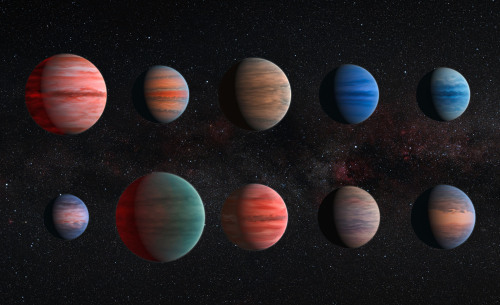
This image shows an artist’s impression of the 10 Hot Jupiter Exoplanets studied using the Hubble and Spitzer Space Telescopes. From the upper left to the lower right corner, these planets are WASP-12b, WASP-6b, WASP-31b, WASP-39b, HD 189733b, HAT-P-12b, WASP-17b, WASP-19b, HAT-P-1b And HD 209458b.
Credit: ESA / Hubble & NASA
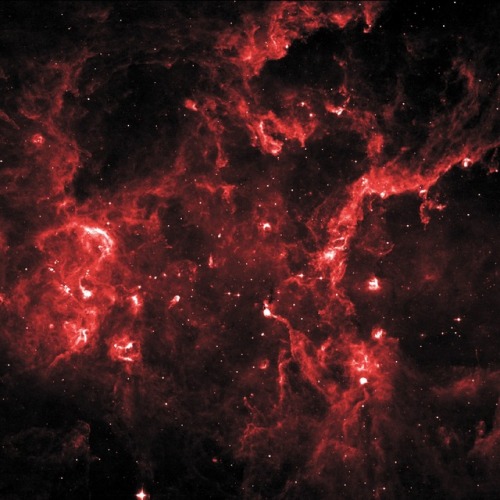
Young Stellar Grouping in Cygnus X
Cygnus X hosts many young stellar groupings. The combined outflows and ultraviolet radiation from the region’s numerous massive stars have heated and pushed gas away from the clusters, producing cavities of hot, lower-density gas.
In this 8-micron infrared image, ridges of denser gas mark the boundaries of the cavities. Bright spots within these ridges show where stars are forming today.
Credit: NASA/IPAC/MSX
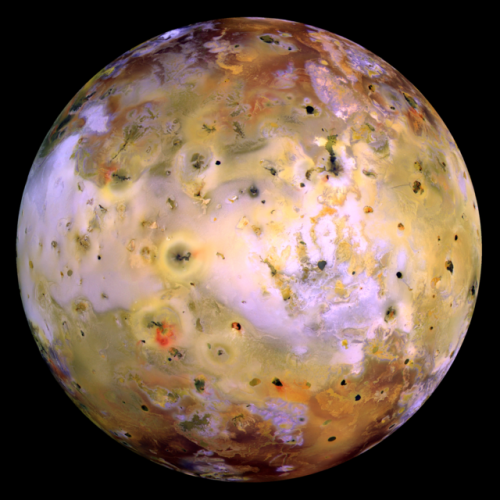
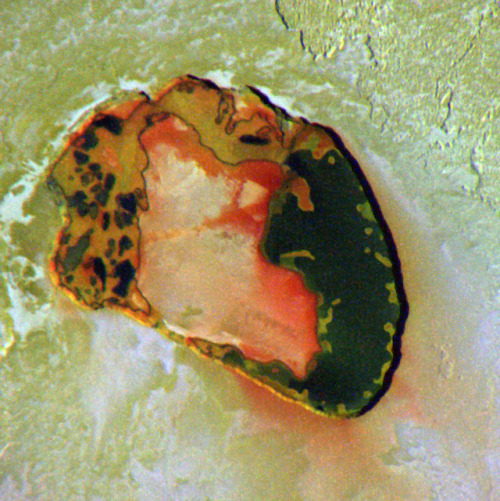
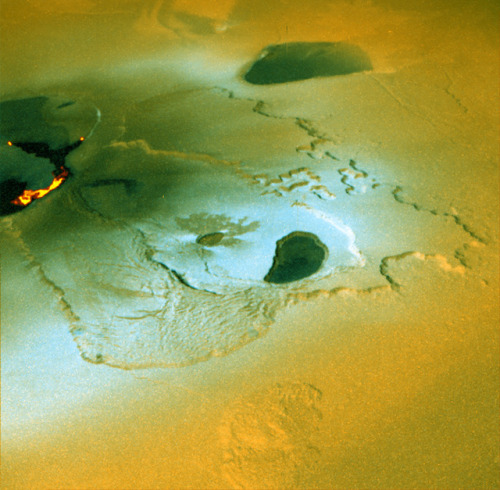
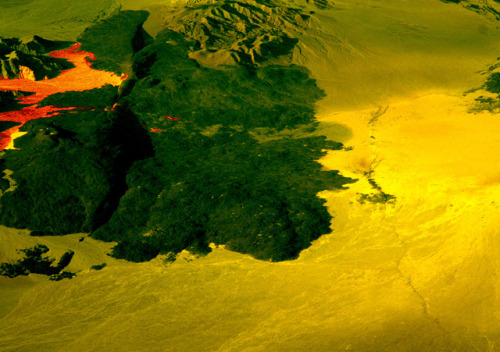
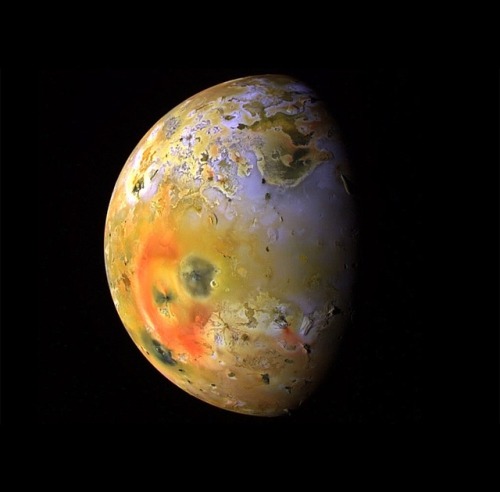
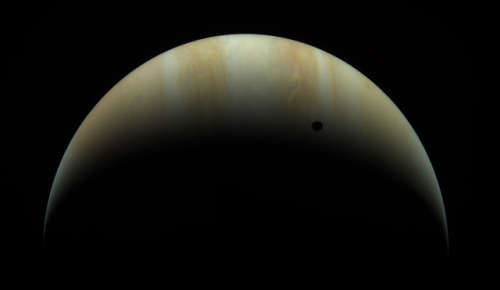
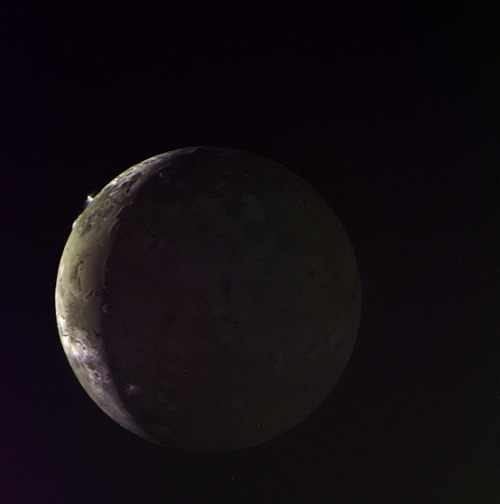
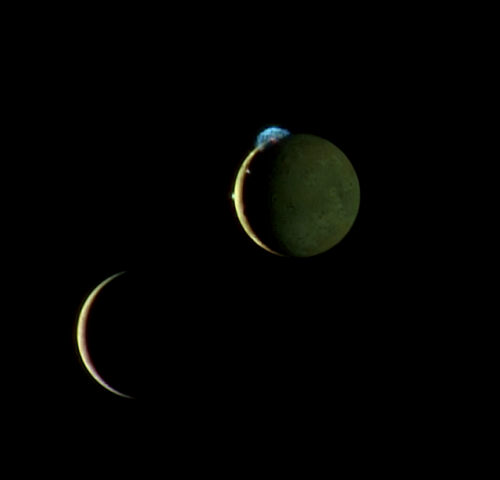
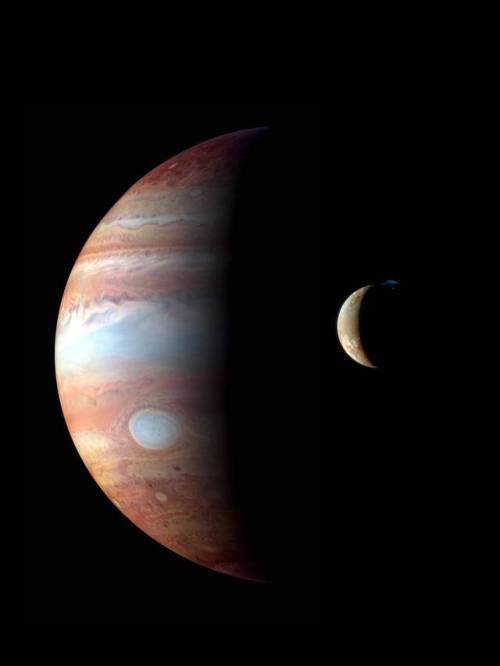
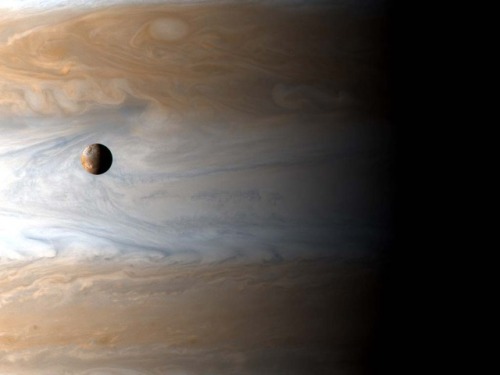
Io - The Volcanic Moon
Looking like a giant pizza covered with melted cheese and splotches of tomato and ripe olives, Io is the most volcanically active body in the solar system. Volcanic plumes rise 300 km (190 miles) above the surface, with material spewing out at nearly half the required escape velocity.
A bit larger than Earth’s Moon, Io is the third largest of Jupiter’s moons, and the fifth one in distance from the planet.
Although Io always points the same side toward Jupiter in its orbit around the giant planet, the large moons Europa and Ganymede perturb Io’s orbit into an irregularly elliptical one. Thus, in its widely varying distances from Jupiter, Io is subjected to tremendous tidal forces. These forces cause Io’s surface to bulge up and down (or in and out) by as much as 100 m (330 feet)! Compare these tides on Io’s solid surface to the tides on Earth’s oceans. On Earth, in the place where tides are highest, the difference between low and high tides is only 18 m (60 feet), and this is for water, not solid ground!
This tidal pumping generates a tremendous amount of heat within Io, keeping much of its subsurface crust in liquid form seeking any available escape route to the surface to relieve the pressure. Thus, the surface of Io is constantly renewing itself, filling in any impact craters with molten lava lakes and spreading smooth new floodplains of liquid rock. The composition of this material is not yet entirely clear, but theories suggest that it is largely molten sulfur and its compounds (which would account for the varigated coloring) or silicate rock (which would better account for the apparent temperatures, which may be too hot to be sulfur). Sulfur dioxide is the primary constituent of a thin atmosphere on Io. It has no water to speak of, unlike the other, colder Galilean moons. Data from the Galileo spacecraft indicates that an iron core may form Io’s center, thus giving Io its own magnetic field.
Io was discovered on 8 January 1610 by Galileo Galilei. The discovery, along with three other Jovian moons, was the first time a moon was discovered orbiting a planet other than Earth.

Eruption of the Tvashtar volcano on Jupiter’s moon Io, photographed by New Horizons.
Image credit: NASA/JPL/Galileo/New Horizons ( Stuart Rankin | Kevin Gill)
Source: NASA

Composed of gas and dust, the pictured pillar resides in a tempestuous stellar nursery called the Carina Nebula, located 7500 light-years away in the southern constellation of Carina.
Credit: NASA, ESA and the Hubble SM4 ERO Team
evosia Chasing auroras is much like living life: if you show up, always be prepared for the amazing to happen.
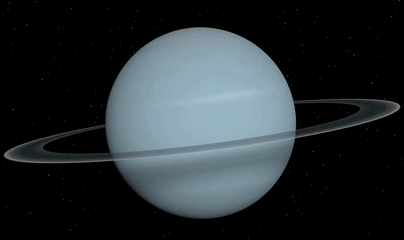
Planet Uranus ♅
Equatorial Diameter: 51.118 km
Satellites: 27
Notable satellites: Oberon, Titania, Miranda, Ariel & Umbriel
Orbit Distance: 2.870.658.186 km (19 AU)
Orbit Period: 84 Earth years
Surface Temperature: -220°C
Discovered Date: March 13th 1781
Discovered By: William Herschel
Image credit: Oscar Malet
Solar System: Things To Know This Week
Weather permitting, you can observe the Moon most nights, unless it’s a new moon, when the lighted side of the Moon faces away from Earth. The Moon is by far the brightest object in the night sky and there’s plenty to see. But this week is special…

…October 28 is International Observe the Moon Night (also known as InOMN).
Here’s all you need to know to join in and celebrate:
1. One Planet. One Moon. One Night.

Everyone on Earth is invited to join the celebration by hosting or attending an InOMN event and uniting on one day each year to look at and learn about the Moon together.
2. What’s Up?

October’s night skies are full of sights, from the first quarter Moon on InOMN to Saturn making a cameo appearance above the Moon October 23 and 24. Watch our What’s Up video for details.
3. Be Social

Hundreds of events are planned around the globe. Click the top link on this page for a handy map. You can also register your own event.
4. Don’t Just Stand There

Here are some activities for enhanced Moon watching.
5. Impress Your Friends with Moon Knowledge

Download InOMN flyers and handouts, Moon maps and even some pre-made presentations. There’s even a certificate to mark your participation.
6. Guide to the Face of the Moon

Almost dead center on the Earth-facing side of the Moon is the Surveyor 6 robotic spacecraft impact side. Apollo 12 and 14 are a bit to the left. And Apollo 11 - the first steps on the moon - are to the right. This retro graphic tells the whole story.
7. Moon Shots

NASA photographers have done some exceptional work capturing views of the Moon from Earth. Here are a few galleries:
You can’t have a solar eclipse without the Moon.
The 2016 “Supermoon” was pretty spectacular.
The Moon gets eclipsed, too.
That IS a Moon - AND the International Space Station.
The Moon is always a great photo subject.
Some spooky shots of the 2014 “Supermoon.”
And 2013.
Tips from a NASA pro for photographing the Moon.
8. Walking on the Moon

Twelve human beings walked on the face of the Moon. Here are some of the best shots from the Apollo program.
9. Moon Watch

Our Lunar Reconnaissance Orbiter is up there right now, mapping the moon and capturing some spectacular high-resolution shots.
10. Keep Exploring

Make our Moon portal your base for further lunar exploration.
Check out the full version of ‘Ten Things to Know This Week’ HERE.
Make sure to follow us on Tumblr for your regular dose of space: http://nasa.tumblr.com.
ISS | Credit: NASA
Time-lapse imagery captured June 25, 2017 by Expedition 52.
What are brown dwarfs?
In order to understand what is a brown dwarf, we need to understand the difference between a star and a planet. It is not easy to tell a star from a planet when you look up at the night sky with your eyes. However, the two kinds of objects look very different to an astronomer using a telescope or spectroscope. Planets shine by reflected light; stars shine by producing their own light. So what makes some objects shine by themselves and other objects only reflect the light of some other body? That is the important difference to understand – and it will allow us to understand brown dwarfs as well.

As a star forms from a cloud of contracting gas, the temperature in its center becomes so large that hydrogen begins to fuse into helium – releasing an enormous amount of energy which causes the star to begin shining under its own power. A planet forms from small particles of dust left over from the formation of a star. These particles collide and stick together. There is never enough temperature to cause particles to fuse and release energy. In other words, a planet is not hot enough or heavy enough to produce its own light.

Brown dwarfs are objects which have a size between that of a giant planet like Jupiter and that of a small star. In fact, most astronomers would classify any object with between 13 times the mass of Jupiter and 75 times the mass of Jupiter to be a brown dwarf. Given that range of masses, the object would not have been able to sustain the fusion of hydrogen like a regular star; thus, many scientists have dubbed brown dwarfs as “failed stars”.

A Trio of Brown Dwarfs
This artist’s conception illustrates what brown dwarfs of different types might look like to a hypothetical interstellar traveler who has flown a spaceship to each one. Brown dwarfs are like stars, but they aren’t massive enough to fuse atoms steadily and shine with starlight – as our sun does so well.

On the left is an L dwarf, in the middle is a T dwarf, and on the right is a Y dwarf. The objects are progressively cooler in atmospheric temperatures as you move from left to right. Y dwarfs are the newest and coldest class of brown dwarfs and were discovered by NASA’s Wide-field Infrared Survey Explorer, or WISE. WISE was able to detect these Y dwarfs for the first time because it surveyed the entire sky deeply at the infrared wavelengths at which these bodies emit most of their light. The L dwarf is seen as a dim red orb to the eye. The T dwarf is even fainter and appears with a darker reddish, or magenta, hue. The Y dwarf is dimmer still. Because astronomers have not yet detected Y dwarfs at the visible wavelengths we see with our eyes, the choice of a purple hue is done mainly for artistic reasons. The Y dwarf is also illustrated as reflecting a faint amount of visible starlight from interstellar space.
In this rendering, the traveler’s spaceship is the same distance from each object. This illustrates an unusual property of brown dwarfs – that they all have the same dimensions, roughly the size of the planet Jupiter, regardless of their mass. This mass disparity can be as large as fifteen times or more when comparing an L to a Y dwarf, despite the fact that both objects have the same radius. The three brown dwarfs also have very different atmospheric temperatures. A typical L dwarf has a temperature of 2,600 degrees Fahrenheit (1,400 degrees Celsius). A typical T dwarf has a temperature of 1,700 degrees Fahrenheit (900 degrees Celsius). The coldest Y dwarf so far identified by WISE has a temperature of less than about 80 degrees Fahrenheit (25 degrees Celsius).
Sources: starchild.gsfc.nasa.gov & nasa.gov
image credit: NASA / JPL-Caltech
-
 mrkng liked this · 1 year ago
mrkng liked this · 1 year ago -
 pugtails liked this · 1 year ago
pugtails liked this · 1 year ago -
 christabelq liked this · 3 years ago
christabelq liked this · 3 years ago -
 metaconscious liked this · 3 years ago
metaconscious liked this · 3 years ago -
 all11is11one reblogged this · 3 years ago
all11is11one reblogged this · 3 years ago -
 tmbird liked this · 3 years ago
tmbird liked this · 3 years ago -
 wakayume liked this · 3 years ago
wakayume liked this · 3 years ago -
 violetbooklover liked this · 4 years ago
violetbooklover liked this · 4 years ago -
 inkypines liked this · 4 years ago
inkypines liked this · 4 years ago -
 negoed12 reblogged this · 4 years ago
negoed12 reblogged this · 4 years ago -
 negoed12 liked this · 4 years ago
negoed12 liked this · 4 years ago -
 smashtonian reblogged this · 4 years ago
smashtonian reblogged this · 4 years ago -
 begmesrr liked this · 4 years ago
begmesrr liked this · 4 years ago -
 sirboneybutt reblogged this · 4 years ago
sirboneybutt reblogged this · 4 years ago -
 sirboneybutt liked this · 4 years ago
sirboneybutt liked this · 4 years ago -
 boo-imma-ghosty13 reblogged this · 4 years ago
boo-imma-ghosty13 reblogged this · 4 years ago -
 boo-imma-ghosty13 liked this · 4 years ago
boo-imma-ghosty13 liked this · 4 years ago -
 booboo666 liked this · 4 years ago
booboo666 liked this · 4 years ago -
 pipsirknight liked this · 4 years ago
pipsirknight liked this · 4 years ago -
 disedi-blog liked this · 4 years ago
disedi-blog liked this · 4 years ago -
 screwmeup reblogged this · 4 years ago
screwmeup reblogged this · 4 years ago -
 dndknight liked this · 4 years ago
dndknight liked this · 4 years ago -
 lostinthemosss liked this · 4 years ago
lostinthemosss liked this · 4 years ago -
 cantkillmeimalreadydead liked this · 4 years ago
cantkillmeimalreadydead liked this · 4 years ago -
 spiritgeyed liked this · 4 years ago
spiritgeyed liked this · 4 years ago -
 spiritgeyed reblogged this · 4 years ago
spiritgeyed reblogged this · 4 years ago -
 ollifallsfromgrace reblogged this · 4 years ago
ollifallsfromgrace reblogged this · 4 years ago -
 ollifallsfromgrace liked this · 4 years ago
ollifallsfromgrace liked this · 4 years ago -
 richardscurls liked this · 4 years ago
richardscurls liked this · 4 years ago -
 taurustheheirophant reblogged this · 4 years ago
taurustheheirophant reblogged this · 4 years ago -
 taurustheheirophant liked this · 4 years ago
taurustheheirophant liked this · 4 years ago -
 apollonnis liked this · 4 years ago
apollonnis liked this · 4 years ago -
 raeentity liked this · 4 years ago
raeentity liked this · 4 years ago -
 mikumylove liked this · 4 years ago
mikumylove liked this · 4 years ago -
 naumansblog liked this · 4 years ago
naumansblog liked this · 4 years ago -
 spaceboyrocky reblogged this · 4 years ago
spaceboyrocky reblogged this · 4 years ago -
 spaceboyrocky liked this · 4 years ago
spaceboyrocky liked this · 4 years ago -
 lemurianx reblogged this · 4 years ago
lemurianx reblogged this · 4 years ago -
 spriggen reblogged this · 4 years ago
spriggen reblogged this · 4 years ago -
 wayward-bumblebee reblogged this · 4 years ago
wayward-bumblebee reblogged this · 4 years ago -
 wayward-bumblebee liked this · 4 years ago
wayward-bumblebee liked this · 4 years ago -
 givemedeath liked this · 4 years ago
givemedeath liked this · 4 years ago -
 mamita-5 liked this · 4 years ago
mamita-5 liked this · 4 years ago -
 happy-joyful-spirit liked this · 4 years ago
happy-joyful-spirit liked this · 4 years ago -
 seasunwitch reblogged this · 4 years ago
seasunwitch reblogged this · 4 years ago -
 steampunk-ghostxx liked this · 4 years ago
steampunk-ghostxx liked this · 4 years ago
For more content, Click Here and experience this XYHor in its entirety!Space...the Final Frontier. Let's boldly go where few have gone before with XYHor: Space: Astronomy & Spacefaring: the collection of the latest finds and science behind exploring our solar system, how we'll get there and what we need to be prepared for!
128 posts